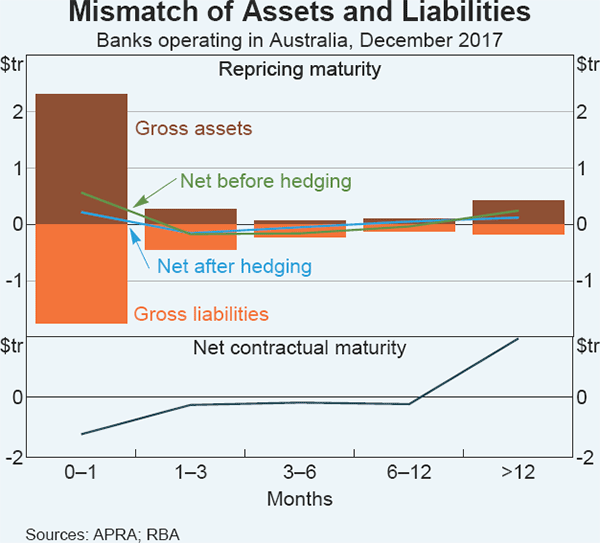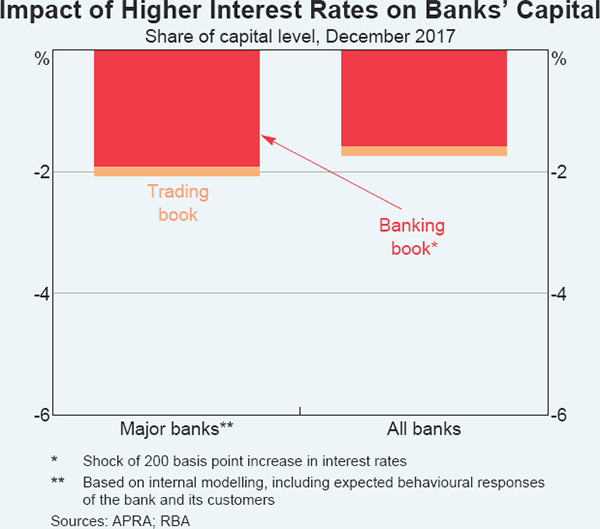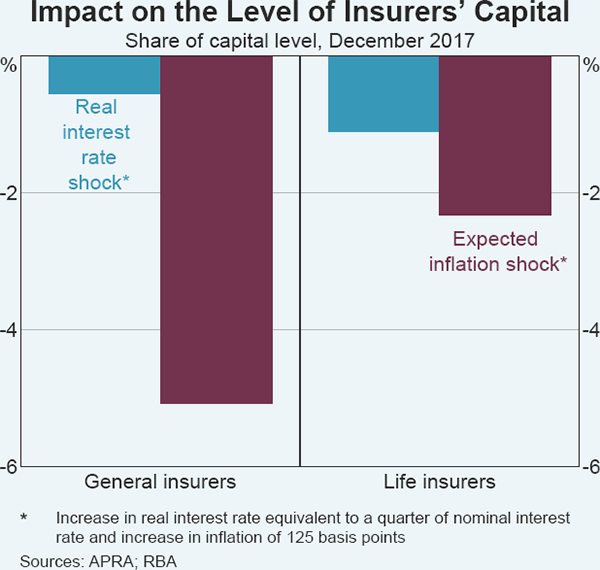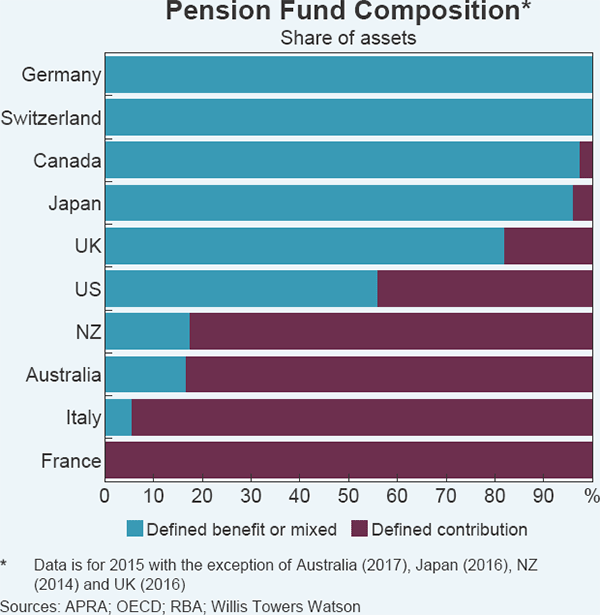Financial Stability Review – April 2018 Box C: Interest Rate Risk in the Australian Financial System
There is a risk that global interest rates will rise quickly to more historically normal levels, as flagged in ‘The Global Financial Environment’ chapter. This could lead to substantial losses for financial entities exposed to interest rate risk. Internationally, a number of central banks have been warning that financial institutions in their country are vulnerable to large losses if interest rates were to rise rapidly and significantly. Such warnings are based, in part, on a large body of empirical evidence that highlights the exposure of various financial institutions to changes in interest rates.[1] This box looks at the exposure of Australian financial institutions to interest rate risk. It shows that, in aggregate, they appear to be exposed to relatively little interest rate risk, which is instead mostly borne by customers and policyholders. As a result, the main risk to Australian financial institutions from higher interest rates is through indirect channels, such as an increase in household and business loan impairments and/or reduced demand for financial services.
Banks
For banks, interest rate risk arises from the majority of their liabilities being short term (either deposits or short-term wholesale debt) while most of their assets are long term (loans). This maturity mismatch can cause banks' margins to narrow following a rise in short-term interest rates, as the cost of their liabilities typically rises almost instantaneously but the return on their existing long-term assets remains constant. This effect may be compounded if the slope of the yield curve flattens (as is common when policy rates rise). In that instance, the spread banks earn when transforming short-term liabilities into long-term assets is reduced, so that even when long-term assets reprice, the increase in their interest rates may be less than on short-term liabilities.
Banks, including in Australia, engage in considerable maturity transformation. For the Australian banking system as a whole, the liabilities that are due to mature within one month exceed the assets (typically housing and business loans) that will mature within that time by over $1 trillion (Graph C1; bottom panel). However, it is the repricing maturity that matters for interest rate risk – that is, how quickly the interest rates of banks' assets and liabilities can be adjusted in response to changing circumstances. Unlike in many other countries, Australian banks have more assets that can be repriced within one month than they do liabilities (Graph C1; top panel). This is primarily because around 80 per cent of Australian housing loans are priced using a variable interest rate that can move with short-term interest rates, and most Australian business loans are priced at a fixed premium to the 3-month bank bill swap rate. This is different from the structure in most other advanced countries, where, in particular, a large share of their housing loan interest rates is fixed for between 5 and 30 years (Badarinza et al 2017).[2]

Australian banks further reduce their exposure to interest rate risk by engaging in derivative trades. While they enter into a wide range of derivative trades, including some that have no impact on their interest rate risk, the net effect of these trades is to make their repricing maturity schedule more balanced.
A second way that banks are exposed to interest rate risk is through potential losses on their fixed-income securities. Higher interest rates reduce the value of fixed-rate bonds since future fixed coupon payments are effectively worth less, given the higher interest rate today. Internationally such effects have often been important, most notably in 1994 when a sharp rise in US interest rates saw US banks (and other investors) post large losses. However, Australian banks' exposures to this risk are relatively small because their trading securities comprise only 5 per cent of their total assets.[3] In contrast, such securities are often around 20 per cent of assets in the banking systems of other advanced economies.
The Australian Prudential Regulation Authority (APRA) requires banks to summarise and report on the extent of interest rate risk that they face. For the ‘banking book’, this is measured as the expected change in economic value from a 200 basis point increase in interest rates at all maturities.[4] For the ‘trading book’, banks must calculate their exposures to interest rate (and other market) risk based on factors such as the credit quality, duration and historical volatility of the securities held. The major banks are required to hold sufficient capital to protect themselves against the adverse impact of higher interest rates on their future profitability, to mitigate the risk of losses in the event of stress.
These estimates imply that the impact of higher interest rates on Australian banks would be modest, at around 2 per cent of their current capital level (Graph C2), which is much less than in many other countries.[5] Almost all of this risk arises from the small residual mismatch in how quickly Australian banks expect to be able to reprice their assets and liabilities that are held in their banking book. The extent of risk arising from expected losses on securities held in their trading book is small, reflecting the modest size of banks' holdings.

Insurance
The impact of higher interest rates on insurers is more complex as there are multiple effects, some of which work in opposing directions. In principle, higher interest rates reduce the value of both the assets and liabilities of the insurance sector, with the net impact on capital therefore determined by differences in the size and maturity (or duration) of each of these components.[6]
Higher interest rates typically reduce the net present value of insurers' liabilities, as a higher discount rate is applied to future expected payments (using a benchmark rate, such as an equivalent-maturity sovereign bond). However, there are complications that can offset this discounting effect and leave the net present value of insurance sector liabilities little changed. For example, there may be no change in liabilities if interest rates rise because of an expectation that inflation will increase, rather than because of an increase in real (inflation-adjusted) interest rates. In this case, the increased discount rate will be offset by an assumption that the future value of insurance payouts will also be higher, given that insurance policies typically promise to make payments that are linked to future prices or wages.
The fall in the value of insurance sector assets in response to higher interest rates results from losses on bonds held by insurers, as described earlier. However, this risk may be passed onto policy holders, such as when a life insurance policy offers a variable payout that is linked to the return on underlying assets.
To determine the net impact of these various factors, APRA requires both general and life insurers to estimate and report on the loss of economic value that would arise if either real interest rates rose (by the equivalent of one-quarter of the current nominal risk-free interest rate) or if nominal interest rates increased (by 125 basis points) because of a rise in expected inflation. This is the insurance-equivalent concept of the estimates produced by the banking sector and shown in Graph C2.
Estimates show that the impact on capital of an increase in real interest rates is small, as insurers in Australia typically invest in assets that have similar duration to their liabilities (Graph C3). As a consequence, when interest rates rise, the decrease in the value of the liabilities of the insurance sector is offset by a similar-sized decrease in the value of their assets. A second reason for the relatively small effect is that more than half of the assets of Australian life insurers are investment linked, for which the policyholders receive a variable payout that is wholly determined by the returns on the insurers' assets. In such circumstances, the interest rate (or investment) risk is borne directly by the policyholders.

In contrast, an increase in nominal interest rates arising from an expectation of higher inflation can have a material impact on general insurers' capital. This impact occurs because most general insurance policies promise to replace damaged goods or real assets and the future cost of that commitment is dependent on the future price level. A rise in nominal interest rates therefore has little effect on the value of general insurers' liabilities (as the future cost of these rise by the same amount as the discount rate applied to them), but erodes the value of their fixed income assets. This is less of a problem for life insurers than general insurers because of life insurers' high proportion of investment-linked business.
Superannuation
The impact of higher interest rates on pension and superannuation funds also depends on the structure of the industry. Where a fund has promised fixed returns to members, its assets will fall in value due to losses on fixed-income securities, but its liabilities will also decline because of the higher discount rate. (Typically, the value of their liabilities will fall by more than the value of their assets because the former have a longer duration; see RBA (2015)).[7] However, in Australia, the majority of superannuation and other managed funds are ‘defined contribution’ funds. In these funds, there is no guaranteed fixed return to members, who bear all the interest rate (or investment) risk. In this respect, Australia is quite different to many other advanced economies, where ‘defined benefit’ funds that promise a fixed rate of return to members (and hence retain all the price risk) still dominate the pension industry (Graph C4).

Footnotes
This literature finds that banks in the United States, United Kingdom, Switzerland and northern euro area countries all tend to experience capital losses in the short term after a rise in interest rates, but that banks in southern euro area countries are little affected. In contrast, life insurers in the United States and Germany benefit from rising interest rates, while life insurers in other countries, and general insurers worldwide, are unaffected. [1]
Badarinza, C, J Campbell and T Ramadorai (2017), ‘What Calls to ARMs? International Evidence on Interest Rates and the Choice of Adjustable Rate-Mortgages’, Management Science, available at <https://pubsonline.informs.org/doi/10.1287/mnsc.2016.2629>. [2]
‘Trading securities’ refer to securities held in a bank's ‘trading book’, meaning they are held for short-term resale, profit or market-making purposes. Securities that are expected to be held to maturity are typically held in the ‘banking book’. When interest rates change, banks are normally only required to adjust the value of securities in their trading book. [3]
Economic value takes into account the net present value of assets, liabilities and off-balance sheet items, and differs from accounting value that may use other valuation measures (for example, amortised cost). The economic value and accounting value of a bank's banking book can differ substantially, but the two tend to be similar for a bank's trading book. [4]
Basel III specifies 15 per cent as a benchmark for what could be considered an ‘outlier’ bank (that is, one with an unusually high exposure to interest rate risk). Equivalent estimates of interest rate risk in the banking book are around 6 per cent of capital for German commercial banks and 15 per cent of capital for Swiss banks, both of which tend to offer a large share of fixed rate loans. [5]
Duration is a measure of the sensitivity of price to interest rates; the price of assets with a short duration is less affected by movements in interest rates than the price of assets with a long duration. [6]
RBA (2015), ‘Box A: The Effect of Low Yields on Life Insurers and Pension Funds’, Financial Stability Review, October, pp 16–18. [7]